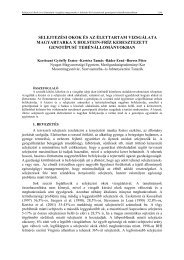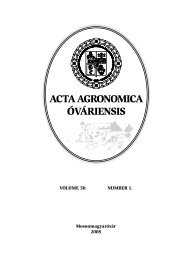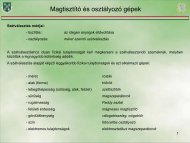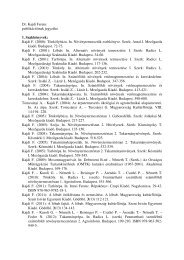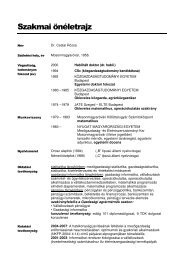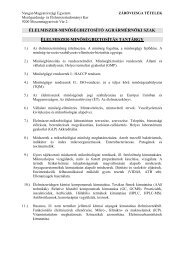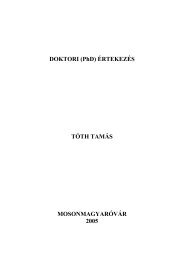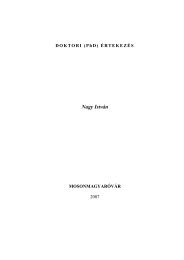50Varga E.– Egerszegi I. – Rátky J. – Kiss R. – Tempfli K. – Bali Papp Á.:Petters, R. M. – Wells, K. D. (1993): Culture of pig embryos. J. Reprod. Fertil. Suppl. 48., 61–73.Rojas, C. – Palomo, M. J. – Albarracín, J. L. – Mogas, T. (2004): Vitrification of immature and invitro matured pig oocytes: study of distribution of chromosomes, microtubules, and actinmicrofilaments. Cryobiol. 49., 211–220.Romar, R. – Coy, P. – Gadea, J. – Rath, D. (2005): Effect of oviductal and cumulus cells on zona pellucidaand cortical granules of porcine oocytes fertilized in vitro with epididymal spermatozoa. Anim.Reprod. Sci. 85., 287–300.Schiewe, M. C. – Rall, W. F. – Stuart, L. D. – Wildt, D. E. (1991): Analysis of cryoprotectant, coolingrate and in situ dilution using conventional freezing or vitrification for cryopreserving sheepembryos. Therio. 36., 279–293.Shi, L. Y. – Jin, H. F. – Kim, J. G. – Kumar, B. M. – Balasubramanian, S. – Choe, S. Y. – Rho, G. J. (2007):Ultra-structural changes and developmental potential of porcine oocytes following vitrification.Anim. Reprod. Sci. 100., 128–140.Silva, C. A. – Cabrera, L. M. – Hata, K. – Kuwayama, M. – Smith, G. D. (2005): Zona pellucidamodifications and fertilization following metaphase II oocyte vitrification and warming. Fertil.Steril. 84., 381.Succu, S. – Leoni, G. G. – Berlingue, F. – Madeddu, M. – Bebbere, D. – Mossa, F. – Bogliolo, L. – Ledda, S.– Naitana, S. (2007a): Effect of vitrification solutions and cooling upon in vitro matured prepubertalovine oocytes. Therio. 68., 107–114.Succu, S. – Leoni, G. G. – Berlingue, F. – Bogliolo, L. – Madeddu, M. – Bebbere, D. – Mossa, F. – Ledda, S.– Naitana, S. (2007b): Vitrification devices affect structural and molecular status of in vitro maturedovine oocytes. Mol. Reprod. Dev. 74., 1337–1344.Vajta, G. – Booth, P. J. – Holm, P. – Greve, T. – Callesen, H. (1997): Successful vitrification of earlystage bovine in vitro produced embryos with the Open Pulled Straw (OPS) method. Cryo-Lett.18., 191–195.Van den Abbeel, E. – Van Steirteghem, A. (2000): Zona pellucida damage to human embryos after cryopreservationand the consequences for their blastomere survival and in vitro viability. Hum.Reprod. 15., 373–378.Van Blerkom, J. – Davis, P. W. (1994): Cytogenetic, cellular, and developmental consequences ofcryopreservation of immature and mature mouse and human oocytes. Micr. Res. Techn. 27.,165–193.Vincent, C. – Pickering, S. J. – Johnson, M. H. (1990): The hardening effects of dimethylsulphoxide onthe mouse zona pellucida requires the presence of an oocytes and in associated with a reductionin the number of cortical granules present. J. Reprod. Fertil. 89., 253–260.Wu, G. M. – Lai, L. – Mao, J. – McCauley, T. C. – Caamaño, J. N. – Cantley, T. – Rieke, A. – Murphy, C. N.– Prather, R. S. – Didion, B. A. – Day, B. N. (2004): Birth of piglets by in vitro fertilization of zonafreepo rcine oocytes. Therio. 62., 1544–1556.Wu, C. – Rui, R. – Dai, J. – Zhang, C. – Ju, S. – Xie, B. – Lu, X. – Zheng, X. (2006): Effects ofcryopreservation on the developmental competence, ultrastructure and cytoskeletal structure ofporcine oocytes. Mol. Reprod. Dev. 73., 1454–1462.A szerzôk levélcíme – Address of the authors:VARGA Erika – KISS Réka – TEMPFLI Károly – BALI PAPP Ágnes<strong>Nyugat</strong>-magyarországi <strong>Egyetem</strong>Mezôgazdaság- és Élelmiszertudományi KarÁllattudományi IntézetH-9200 Mosonmagyaróvár, Vár 2.E-mail: evarga@mtk.nyme.hu, bali@mtk.nyme.huEGERSZEGI István – RÁTKY JózsefÁllattenyésztési és Takarmányozási KutatóintézetH-2053 Herceghalom, Gesztenyés út 1.
ACTA AGRONOMICA ÓVÁRIENSIS VOL. 51. NO. 1.51Most frequent bovine diseases in cattle herdsin the West-Transdanubian RegionNOÉMI VARGA – ERIKA BERTALANNÉ VÁRALLYAY – LAJOS SALAMONUniversity of West HungaryFaculty of Agricultural and Food SciencesInstitute of Business ManagementDepartment of EconomicsMosonmagyaróvárSUMMARYThe political and economical changes in 1989 and 90 influenced Hungary’s agriculturegreatly. The transition hit the branches of animal husbandry more than plant growing.Cattle husbandry is one of the most important branches of agriculture in Hungary. Itsproduction is equally important both for the domestic and for export markets. Under thepresent market conditions Hungary will only be able to maintain its cattle stock if theprofitability and competitiveness of the branch can be enhanced considering the requirementsof the European Union. Therefore the hidden causes of economic losses should berevealed and solutions have to be found in order to eliminate them. It is only possible ifdata on the health state of the herds are available.Several factors influence the profitability of running a dairy farm. Some of them cannotbe influenced at all or little but there are a few factors, which can be changed considerably.Mastitis, fertility problems and metabolic diseases, lameness and several other infectiousdiseases like bovine virus diarrhoea (BVD) and infectious bovine rhinotracheitis (IBR)cause great losses in dairy herds in Hungary. They also cause high losses in countrieswith developed cattle breeding.In our study we wanted to answer the questions: ”What are the most frequent stock healthproblems on cattle farms in the West-Transdanubian region?” and ”How high is the rateof cows culled because of diseases?” We summarised and evaluated the data from questionnairesabout the spread of the following diseases on 30 cattle farms: foot diseases,placenta retention and metritis, clinical and sub-clinical mastitis. Among them sub-clinicalmastitis came highest (13.1%) followed by placenta retention (12.4%), metritis (9.6%) andclinical mastitis (9.5%). Culling owing to diseases reached 20.1% on average during theperiod of the investigation.Keywords: stock diseases, culling, calving interval period, losses.




